Woke up in this Airbnb somewhere outside Wellington. Yellow pillows, those Scandi-style wooden lamps everyone’s obsessed with and me wondering why I booked a 6 AM departure. The mirror setup was perfect for those getting-ready shots though – you know the ones. Natural light streaming through the blinds at 5:30 AM hits different when you’re running on three hours of sleep.
The host left a note about local cafes. Didn’t use it. Coffee could wait until Taupo.
Why New Zealand Roads Are Basically Therap
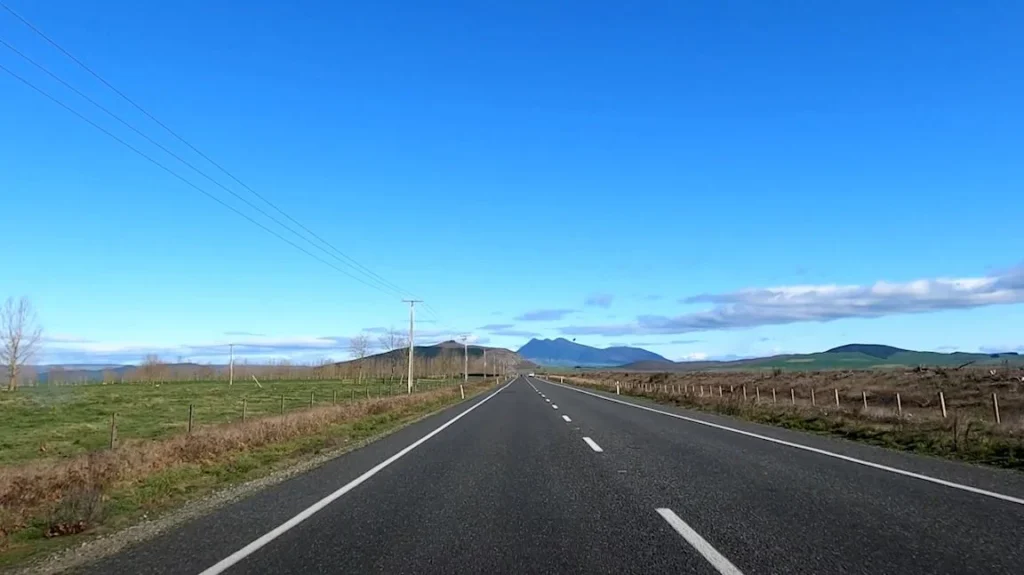
This shot? Somewhere between Waiouru and Taupo. The road just stretches forever, mountains sitting there like they’re posing for postcards. Power lines keeping you company for kilometers.
Here’s what they don’t tell you about driving in New Zealand – it’s meditation with a steering wheel. No billboards screaming at you. No mega-highways. Just tarmac, scenery and the occasional sheep giving you side-eye from a paddock.
Actually pulled over five times just to take it in. Not for photos. Just… to stand there. The silence out here? It’s loud. Does that make sense? Like your ears are searching for noise but finding nothing except wind.
Quick Road Trip Reality Check:
- Wellington to Napier: 320km (but who’s counting?).
- Actual time: 4 hours if you’re efficient.
- My time: 8 hours because squirrel brain.
- Fuel stops: 2 (one necessary, one because I saw a pie shop).
- Wrong turns: 3 (GPS and I weren’t speaking).
The Taupo Detour That Wasn’t Supposed to Happen
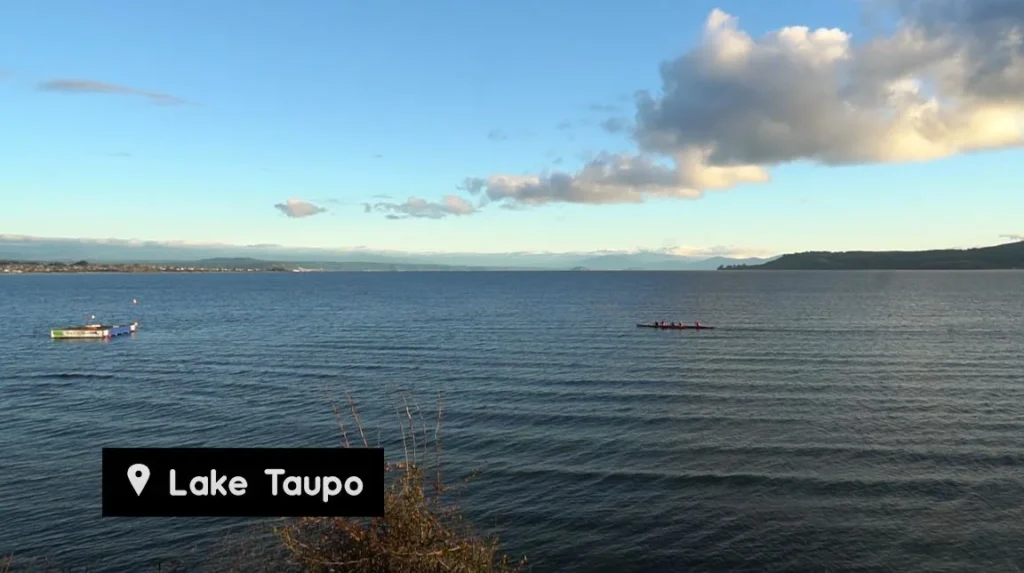
Taupo wasn’t even on my radar for this trip. Just planned to drive through, maybe grab petrol. Then I saw the lake.
You can’t ignore Lake Taupo. It’s like trying to ignore someone playing bagpipes in a library. The water stretches so far you’d think it’s the ocean if you didn’t know better. Those boats out there? Rich people problems I’ll never have. But standing there watching them bob around while clouds do their dramatic thing overhead… free entertainment.
Fun fact I learned from a local: this whole lake is one massive volcanic caldera. We’re talking about an eruption so big it allegedly turned the sky red in Rome and China. 26,500 years ago, but still. Standing on the edge of ancient catastrophe while eating fish and chips? That’s travel.
Huka Falls: Nature Showing Off
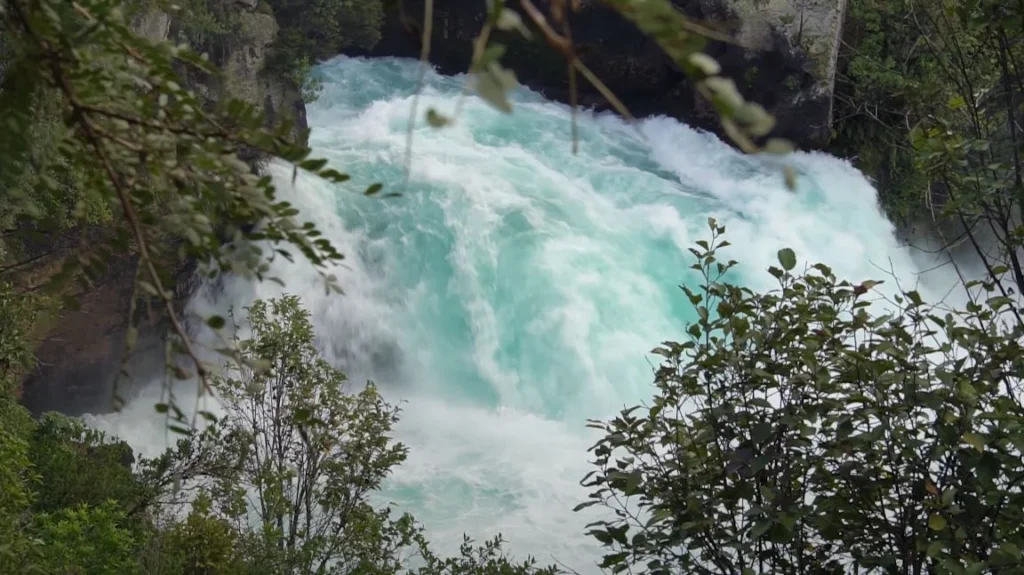
Twenty minutes north of Taupo town, there’s this spot where the Waikato River completely loses it’s mind.
The water – first of all, that COLOR. It’s not normal. Looks fake. Like someone cranked up the saturation slider and broke it. But it’s real, just physics doing it’s thing with bubbles and light. The river gets squeezed from 100 meters wide down to maybe 15 and the water doesn’t handle it well. Or handles it too well? 220,000 liters per second thundering through this canyon.
Stood on that viewing bridge for ages. Japanese tourists taking selfies, kids asking parents why it’s blue, me trying to record the sound on my phone (pointless – phones can’t capture that kind of chaos).
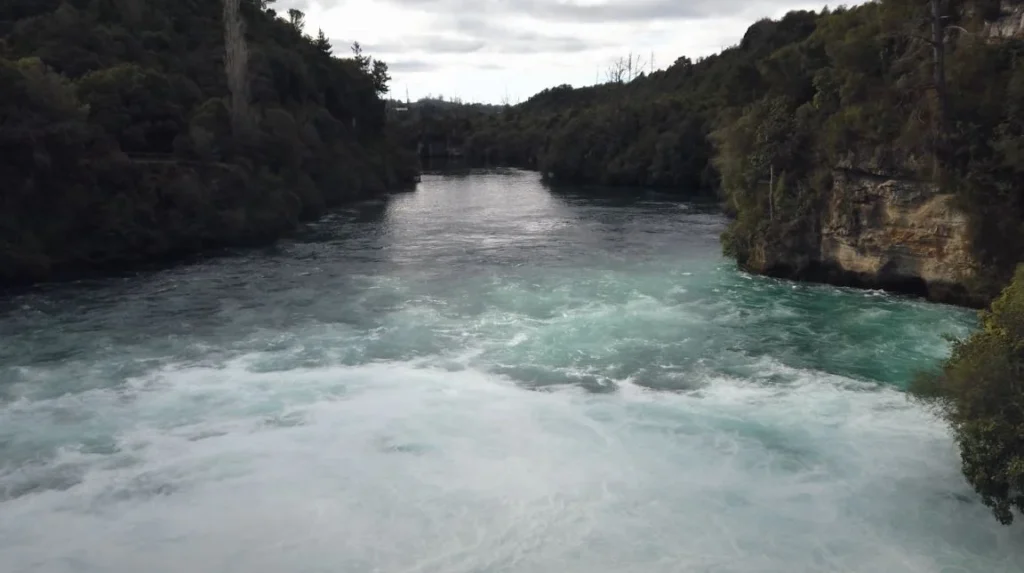
Walked upstream a bit where fewer people go. The river’s still angry but in a different way. Building momentum. You can actually see it gathering speed, like watching someone wind up for a punch.
Spray everywhere. My camera lens? Covered. Jacket? Soaked. Worth it? Absolutely.
Finally: Napier Appears
The drive from Taupo to Napier takes you through wine country. Hills covered in vines, arranged in lines so perfect it looks like someone combed the earth. Then you drop down toward the coast and boom – there’s Napier, sitting pretty on Hawke’s Bay.
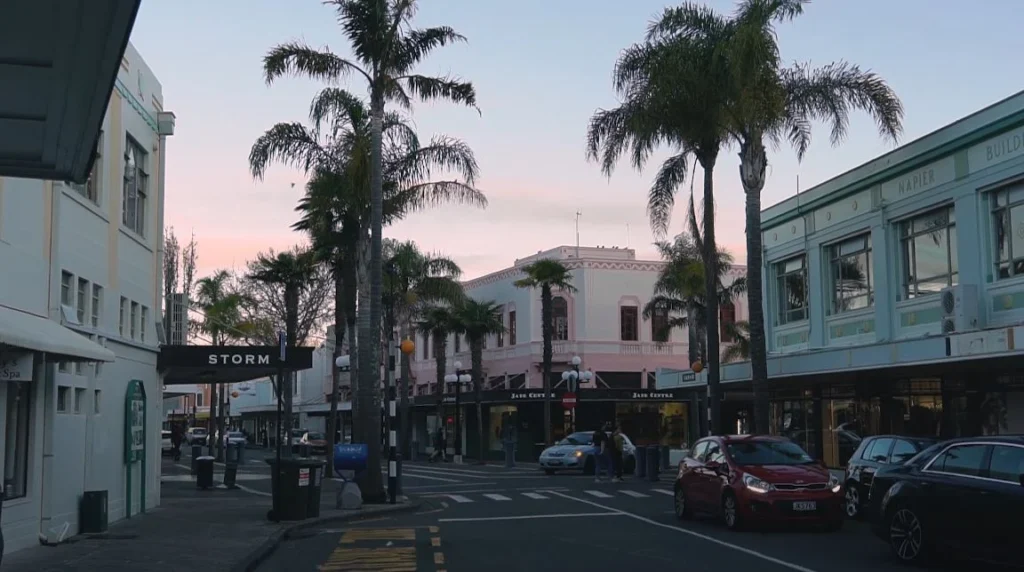
First thing you notice: palm trees. Everywhere. This isn’t typical New Zealand scenery. Someone decided after the 1931 earthquake that if they’re rebuilding from scratch, might as well make it feel like Miami. Or California. Or anywhere that doesn’t remind you of destruction.
The streets are wider than they need to be. Learned later this was intentional – after the earthquake, they wanted space. Room to breathe. Room to run if needed.
The Art Deco Obsession Explained
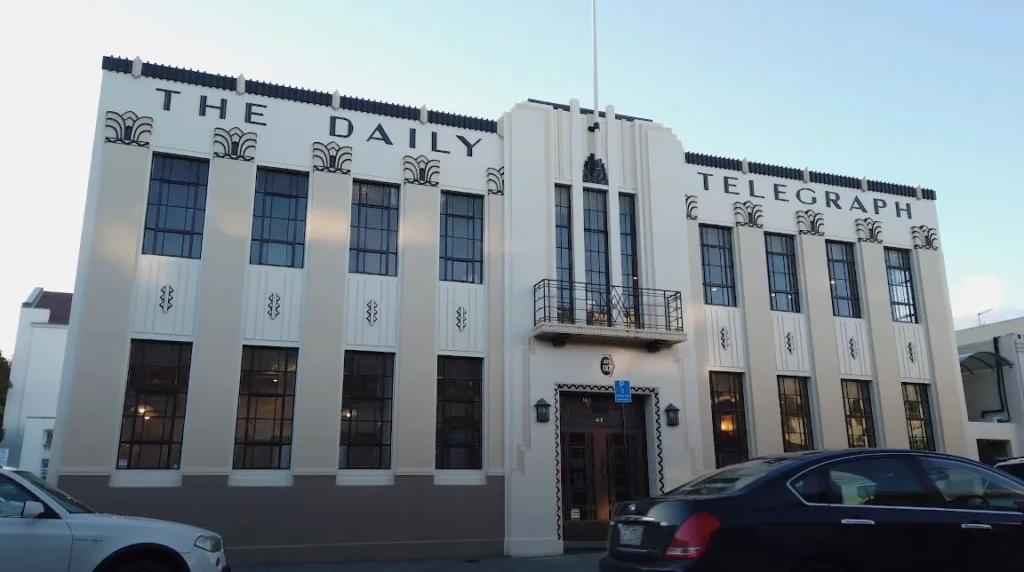
The Daily Telegraph building at sunset. This is when Napier makes sense. Golden light hitting those white walls, shadows playing in the geometric details.
See, when the 1931 earthquake flattened Napier (we’re talking 7.8 magnitude followed by fires), they had to rebuild fast. Middle of the Great Depression, no money, but tons of determination. Art Deco was the style of the moment – modern, optimistic and relatively cheap to build.
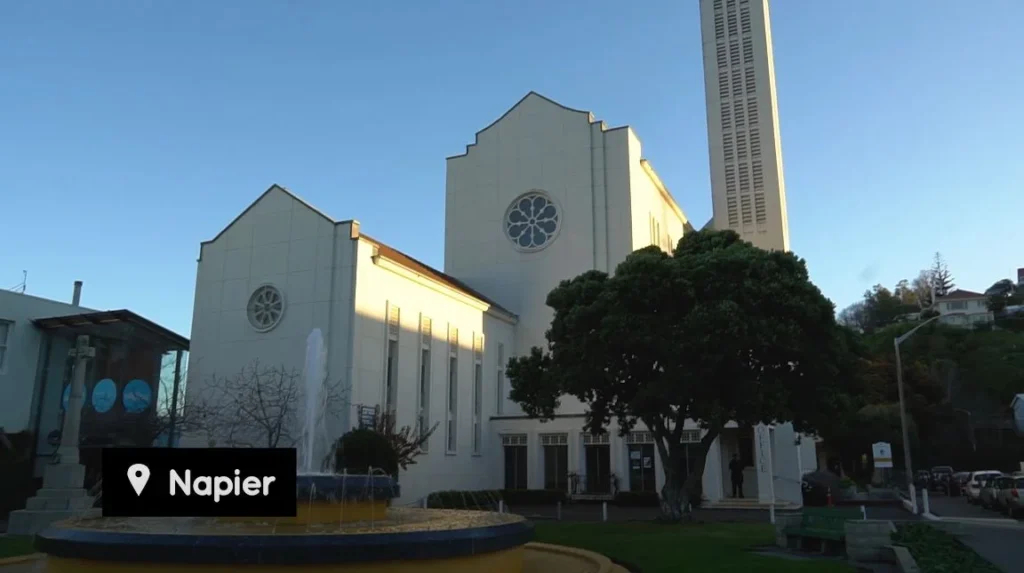
This building? Classic Napier rebuild. Those rose windows aren’t trying to be Gothic – they’re Art Deco interpretation of tradition. The stepped facade, the clean lines, that tower reaching up like it’s trying to prove something. Everything built between 1931-1933 looks like this. An entire city stuck in time, but on purpose.
What Makes Napier’s Architecture Different:
- Horizontal emphasis (earthquakes respect horizontal more than vertical).
- Ziggurat shapes (those stepped pyramid things).
- Curved corners on everything.
- Sunrise motifs (hope after disaster).
- Maori patterns mixed with Deco geometry.
- Spanish Mission influence (because why not?).
- Colors: mostly pastels, whites and creams.
[Insert Image 9 – waterfront Art Deco building here]
This one faces the water. Morning light, Norfolk pines standing guard. The dome isn’t original – added later when they could afford fancy things. But it works. The whole waterfront is like this, building after building refusing to acknowledge that it’s 2024.
Where I Ate (And Why You Should Care)
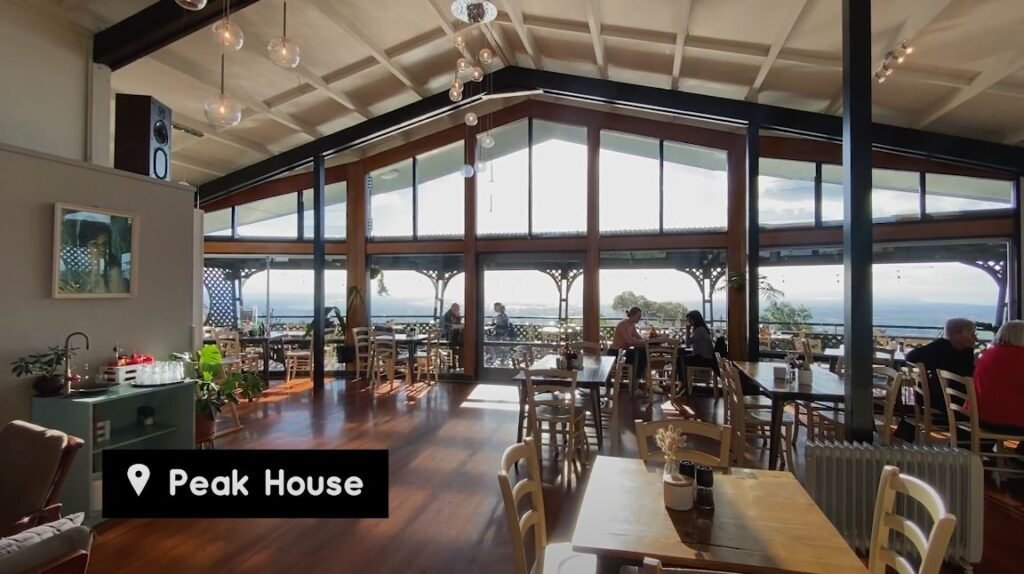
Peak House sits up on Bluff Hill. Those pendant lights, that view through floor-to-ceiling windows… this is where locals take visitors when they want to show off.
Went for breakfast, stayed through lunch. Not because the service was slow (it wasn’t), but because why would you leave? Mountains fade into blue haze across the bay. Coffee strong enough to wake the dead. And that curved pavilion next door adding just enough architectural interest to your Instagram stories.
The menu? Typical Kiwi-elevated. Smashed avo with additions you didn’t know you needed. Eggs benedict that actually justifies the $24 price tag. But really, you’re paying for the view. And it’s worth every cent.
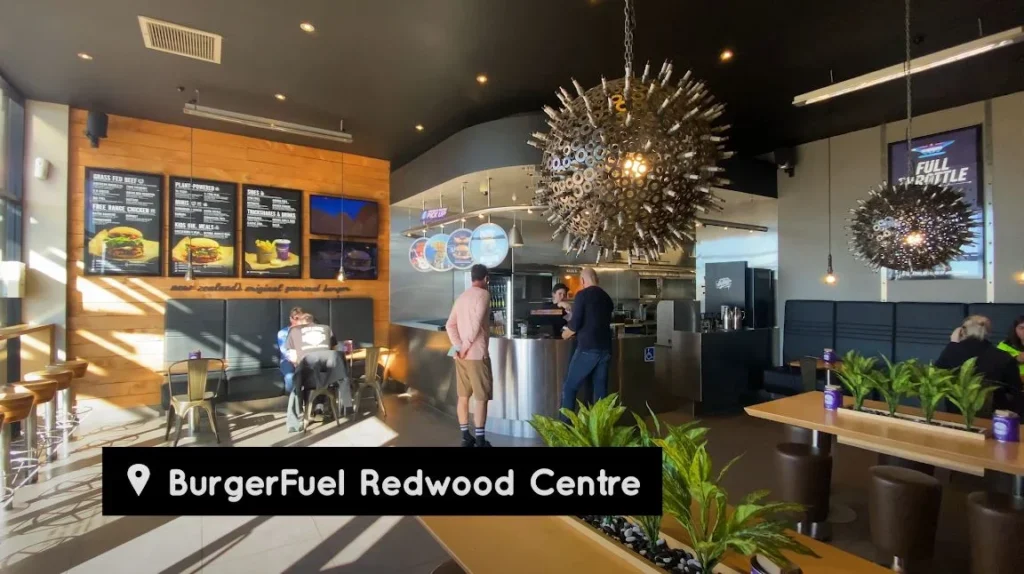
Then there’s BurgerFuel in Redwood Centre. Complete opposite vibe. Those spiky light fixtures that look like sea urchins had babies with disco balls. Very “we’re a chain but we’re a COOL chain” energy.
Honestly? Sometimes you just need a burger. And their kumara (sweet potato) fries hit different after a day of walking.
The Hiking Adventures (Because Sitting Still Is Overrated)
[Insert Image 16 – hiking trail on hillside here]

Te Mata Peak. 3 PM. Wind trying to knock me sideways while I pretend I’m not winded from the climb.
The track starts innocently enough. Gravel path, gentle incline, families with strollers. Then it gets serious. That photo shows maybe halfway up – the path narrows, drops appear on one side and suddenly you’re very aware of your mortality. But you keep going because… well, you’ve come this far and that German couple with the massive backpacks just passed you.
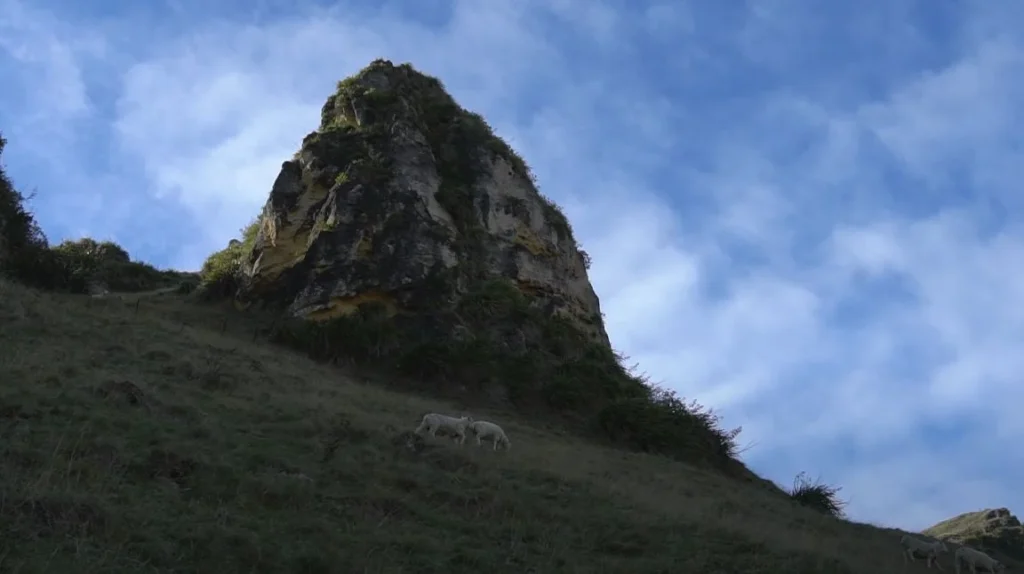
This rock. Standing there like it’s been waiting million years for Instagram. Those sheep? Zero interest in posing. They’ve seen enough tourists to know we’re harmless.
The limestone formations up here tell stories if you know how to read them. Ancient seabed pushed up by tectonic forces, now 400 meters above sea level with sheep using them as windbreaks. The Maori name for this peak is Te Mata-o-Rongokako and there’s a whole legend about a giant who ate his way through the hills and choked on them. Looking at these rocks, you can almost see it.
The Summit Situation
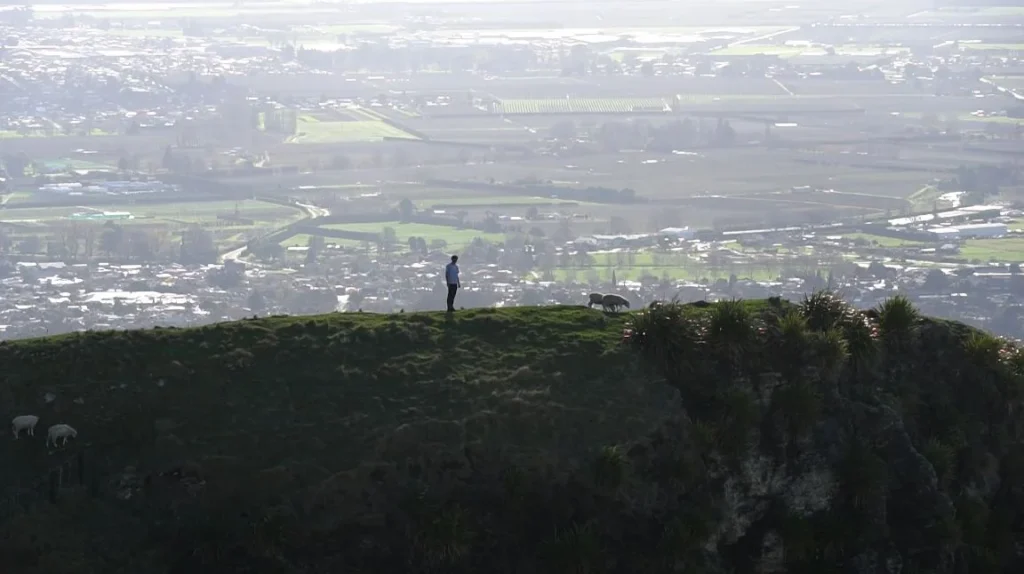
Made it. 399 meters up. Not Everest, but my legs disagree.
That view though? Hawke’s Bay spreading out like someone’s model train set. Vineyards in perfect rows, the city looking tiny and organized, the Pacific doing it’s endless blue thing to the east. Those sheep at the summit have the best real estate in Napier and they don’t even care.
Wind up here doesn’t play. Constant 40km/h with gusts that make you grab onto anything solid. My hair in every photo from the summit looks like I’ve been electrocuted. Worth it for that 360-degree view though.
Te Mata Peak Stats Nobody Asked For:
- Height: 399m (1,309 ft for the Americans).
- Tracks: 3 main ones (I took Peak Trail – most direct, most painful).
- Time up: 45 minutes if you’re fit, 1.5 hours if you’re me.
- Wind speed average: “Yes”.
- Sheep encountered: 47 (I counted).
- People passed by: Don’t want to talk about it.
The Waterfall Hunt (Because I Can’t Help Myself)
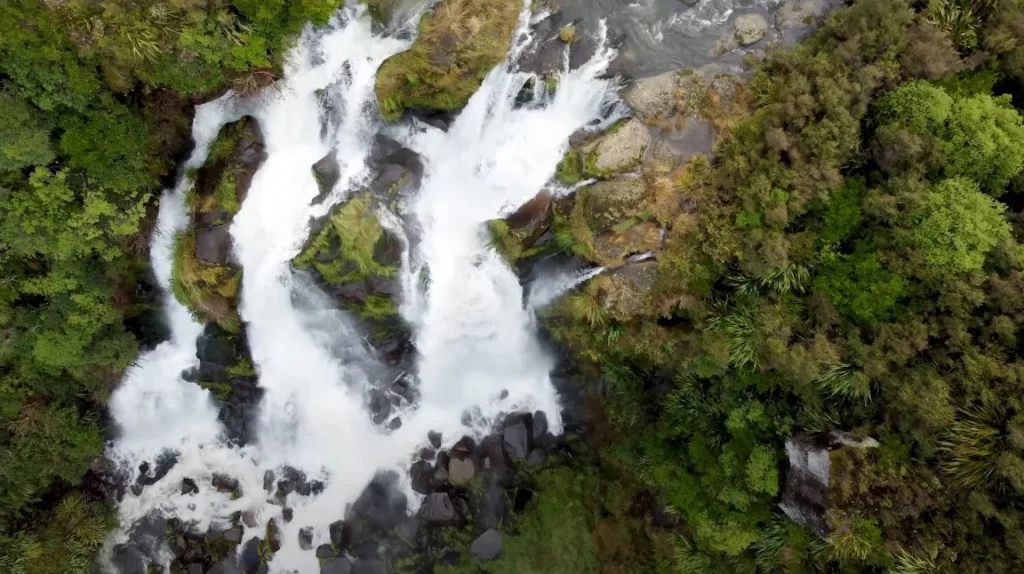
Waipunga Falls. Hour drive northwest from Napier, but JLINHH doesn’t do anything halfway.
Drone shot this one. Yeah, I’m that guy now. But when you see water falling like that through native bush, surrounded by nothing but green… you pull out all the stops. The falls drop 30 meters in two stages, but from above, it looks like the earth just decided to break apart and let water escape.
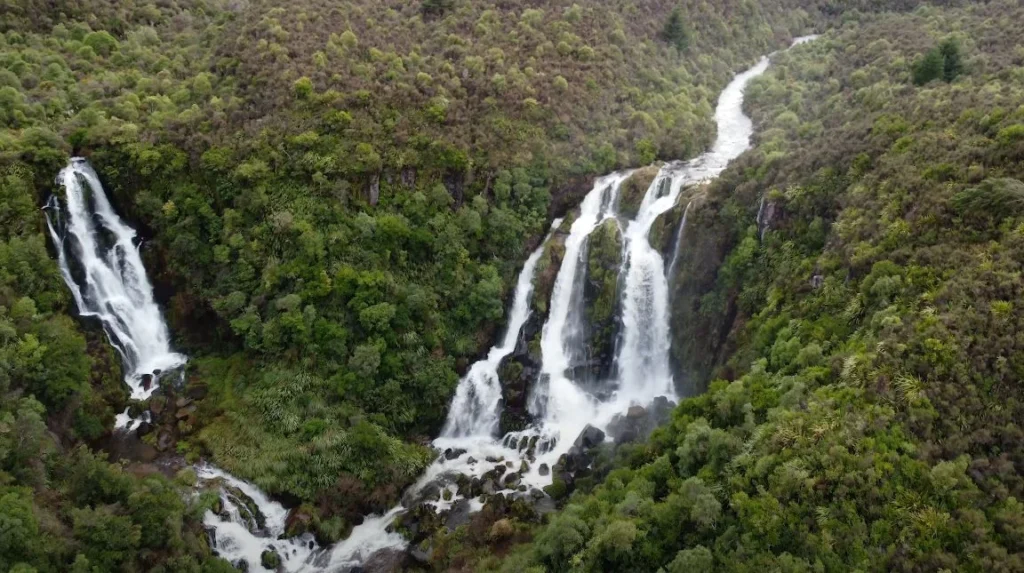
Ground level tells a different story. The power of it. Standing there, mist hitting your face, the sound drowning out everything… this is why I chase waterfalls like some water-obsessed pokemon trainer.
The bush around Waipunga is proper New Zealand native. Ferns everywhere, moss covering everything that stays still long enough, bird sounds you can’t identify. Took the track down to the base – slippery, muddy, probably shouldn’t have done it in sneakers. But getting close enough to feel the ground vibrate? That’s the addiction right there.
Waterfall Chasing Rules I’ve Learned:
- Always bring a microfiber cloth (lens will fog).
- Waterproof everything (learned this the hard way).
- Best light is overcast (harsh sun creates too much contrast).
- Never trust the “easy walk” signs.
- There’s always a better angle if you’re willing to get wet.
The Random Food Encounters
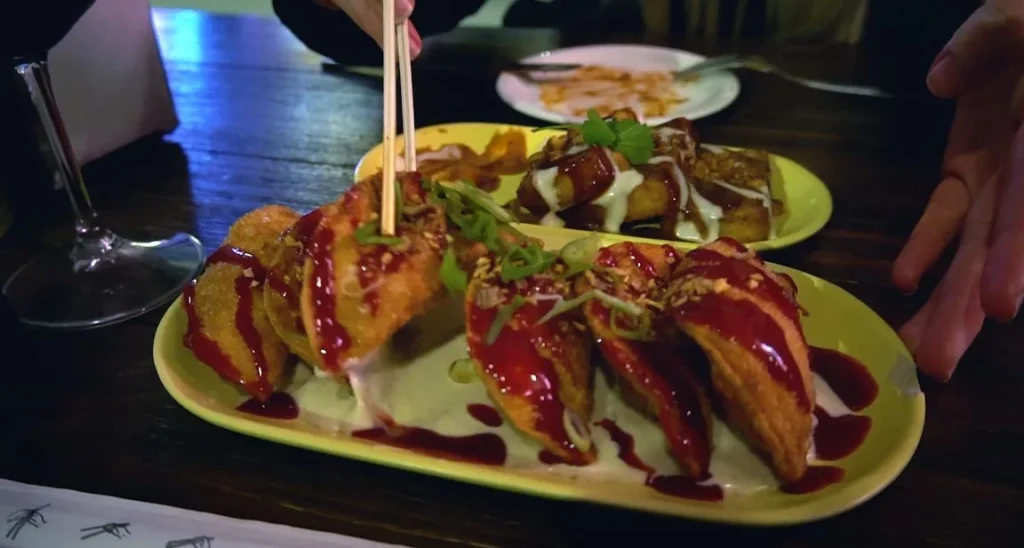
Found this gem in a Napier side street. No name I can remember, just “that place with the insane plating.”
Those aren’t just tacos. They’re someone having an existential crisis with corn tortillas and deciding to resolve it through food art. Raspberry coulis (fancy word for sauce) drizzled like Jackson Pollock discovered Mexican cuisine. Microgreens because it’s 2024 and everything needs microgreens.
Tasted as confused as it looked. Good confused though. Like when you mix all the sodas at a drink fountain as a kid and somehow it works.
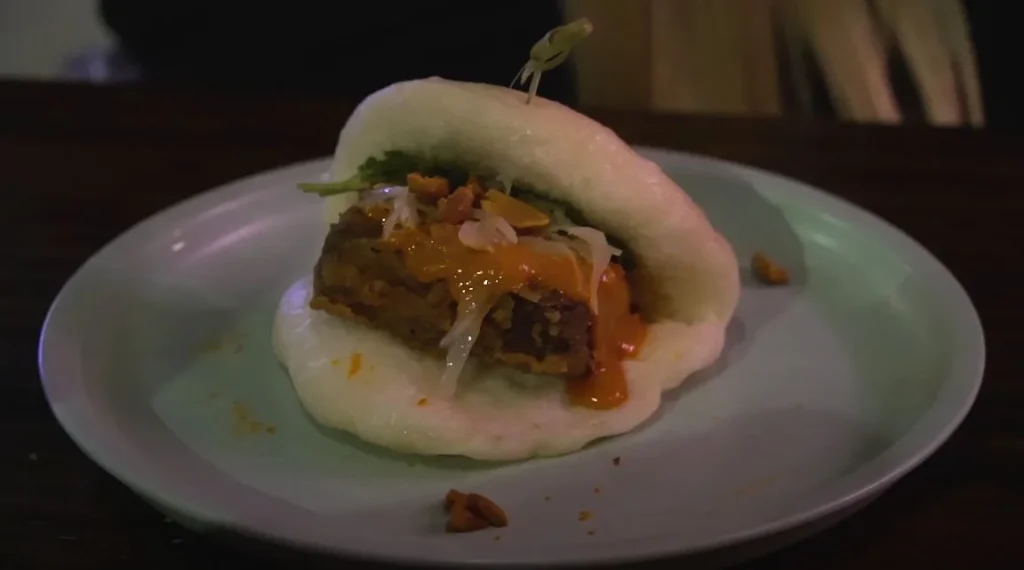
Then there’s this. Steamed bao trying to be fancy.
The filling was some fusion situation – Korean fried chicken meets Kiwi coleslaw meets someone who really likes sriracha. The plating though? Someone went to art school and ended up in a kitchen. That swoosh of sauce probably took longer to perfect than cooking the actual bao.
Here’s what I learned about Napier food scene: they’re trying. Really trying. Sometimes too hard. But after days of meat pies and flat whites, you appreciate the effort.
The Architecture Deep Dive Nobody Asked For
Spent my last full day just walking Napier with no plan except “look up more.”
The city is basically an architecture museum where people live and work. Every building has these details you miss at street level:
- Chevron patterns in the brickwork.
- Curved glass in windows (expensive in 1932, statement piece).
- Stylized flowers and fountains in the facades.
- Speed lines (like the building is moving fast while standing still).
- Nautical themes everywhere (portholes, wave patterns, ship railings).
The National Tobacco Company building (now turned into boutique shops because 2024) has this incredible curved corner with original glass bricks. Light passes through them differently throughout the day. Morning makes them glow gold. Afternoon turns them green-blue.
Why Napier’s Art Deco Works:
- Consistent height limits (earthquake lessons).
- Wide streets (fire breaks).
- Similar color palettes (creams, whites, pastels).
- Everyone rebuilt at once (unified vision).
- Pride in the style (they lean into it, not away).
- Tourism money maintaining it (cynical but true).
The Wine Country Situation (That I Almost Missed)
Hawke’s Bay produces wine. Lots of wine. I’m not a wine person but when in Napier…
Mission Estate, established 1851 by French missionaries who apparently needed communion wine and got carried away. The building sits on this hill overlooking everything, very “we own all you survey” energy. Tried their Chardonnay. Tasted like… wine. The cheese platter though? Now we’re talking.
Church Road Winery had better views but worse cheese. Priorities.
Trinity Hill had the best name and someone who actually explained wine without making me feel stupid. Turns out Hawke’s Bay’s climate is similar to Bordeaux. Similar latitude, maritime influence and gravelly soil. Who knew dirt mattered so much?
Napier Wine Region Reality Check:
- Wineries: 72 (didn’t visit them all, liver said no).
- Main varietals: Chardonnay, Syrah, Merlot.
- Best for novices: Mission Estate (tourist-friendly).
- Best for photos: Elephant Hill (that infinity pool though).
- Best for actually learning: Trinity Hill.
- Amount of wine knowledge retained: 3%.
The Reality of Leaving
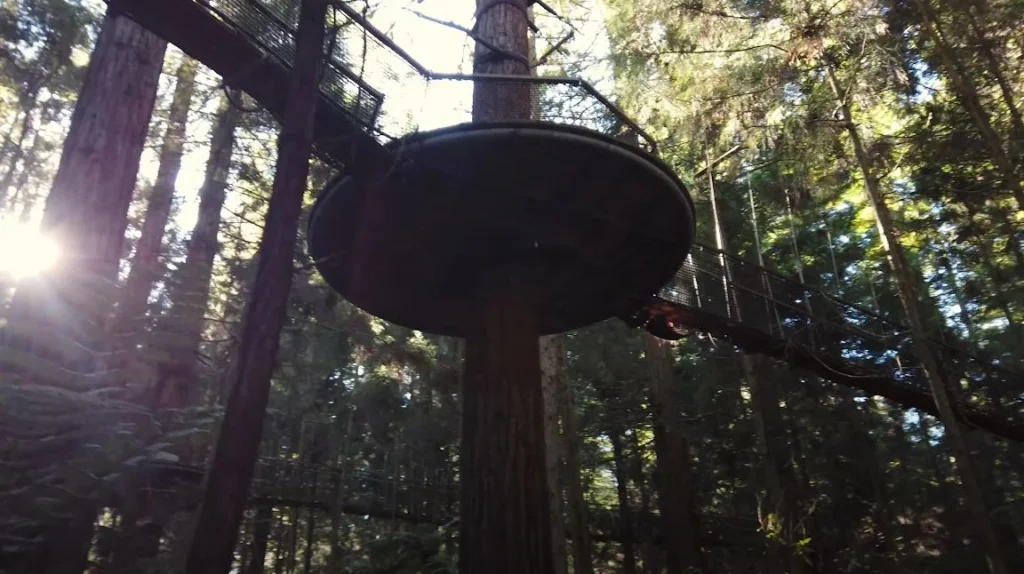
Found this on the way out of Napier. Redwoods Forest, just off State Highway 5.
Not sure what I expected to find pulling into a random forest car park at 8 AM, but it wasn’t this UFO-looking platform suspended between trees. It’s actually a treewalk viewing platform, but at that hour, with mist still clinging to the redwoods and nobody else around? Felt like stumbling into some abandoned sci-fi movie set.
Climbed up there despite the “closed for maintenance” sign (JLINHH makes questionable choices for content). The structure sways. Not dramatically, just enough to remind you you’re standing on something humans built between trees that don’t care about your safety concerns.
The forest up here is silent in that heavy way only forests can be. These aren’t native trees – California redwoods planted in 1901 as a timber experiment. Now they’re just here, being enormous, making everything else look like toys.
The Departure Drama
Leaving Napier feels wrong. Like walking out of a movie you’re enjoying because your parking meter’s running out.
Packed the car while the morning sun lit up those Art Deco buildings one more time. The light at 7 AM hits different than sunset – cleaner, sharper, more honest. Shows all the cracks and imperfections that evening light forgives. Makes the city more real somehow.
Grabbed one last flat white from this place called Crazy Good. Stupid name, excellent coffee. The barista recognized me from my third visit yesterday. “Leaving already?“ Yeah, already. After four days that felt like both forever and five minutes.
Things I Didn’t Get To:
- Cape Kidnappers (gannet colony at the end of the world).
- The aquarium (apparently they have penguins?).
- Art Deco night tour (too touristy even for me).
- About 60 more wineries.
- That one restaurant everyone said I HAD to try.
- The old prison tour.
- Mountain biking trails everyone raved about.
The Drive Back Different Route
Took the coastal route back. Longer, windier, absolutely worth it.
State Highway 2 hugs the coast like it’s afraid of the interior. You’re driving along these cliffs with the Pacific smashing against rocks below, radio cutting in and out and suddenly you understand why people move to New Zealand and never leave.
Stopped at this place called Waipatiki Beach. Nobody there. Just me, black sand and waves that looked angry about something. Found a piece of driftwood shaped like a question mark. Left it there. Some metaphors are too obvious even for travel writing.
The Coastal Route Breakdown:
- Extra time: 2 hours
- Extra petrol: $30
- Photo stops: Lost count after 12
- Near-death experiences: 3 (those corners don’t mess around)
- Regrets: Zero
Travel Truths Nobody Tells You About Napier
After four days, here’s what I actually learned:
The Good Stuff:
- Weather’s generally better than the rest of NZ (rain shadow effect).
- Walkable city center (everything’s within 20 minutes).
- Locals actually like tourists (rare in popular destinations).
- Coffee culture is real (found excellent flat whites everywhere).
- Beach is right there but nobody talks about it.
- Accommodation is reasonable (compared to Wellington/Auckland).
The Reality Check:
- Wind. Constant wind. Your hair will never look good.
- Restaurants close early (9 PM is late night here).
- Winter’s actually cold (those buildings aren’t insulated).
- Weekend wine tours = drunk bus loads of Auckland hens parties.
- Parking meters everywhere downtown (and they check).
- Some Art Deco buildings are just old buildings painted white.
The Surprises:
- Earthquake drills are still a thing (experienced one at a cafe).
- Gangs exist here (Mongrel Mob has actual clubhouses).
- Best Mexican food in NZ (random, but true).
- Mountain biking scene is huge but hidden.
- Street art beyond the Deco stuff is incredible.
- Night life exists, just very specifically located.
The Money Situation
Let’s be real about costs:
| Item | NZD | Reality Check |
| Accommodation (per night) | $120-180 | Airbnb beats hotels here |
| Coffee | $5.50 | Same everywhere in NZ |
| Meal (casual) | $18-25 | Fish and chips cheaper, better |
| Meal (nice) | $35-50 | Peak House worth the splurge |
| Petrol (per 100km) | $25 | Crying is free |
| Wine tasting | $10-20 | Often waived if you buy |
| Entry fees | $0 | Everything’s free except wine |
| Parking | $2/hour | Adds up fast downtown |
Total damage for 4 days: About $800 including accommodation. Could do it for half that if you’re not me and don’t need to eat at every interesting-looking place.
The Photography Reality
Shot over 2000 photos. Posted 23. The ratio hurts but that’s travel photography.
What Actually Worked:
- Golden hour at the waterfront (every photographer ever was right).
- Drone at waterfalls (when wind allows).
- Architecture details in harsh midday sun (shadows create drama).
- People not knowing they’re in frame (candid > posed).
- Rain on Art Deco buildings (that shine though).
What Failed Spectacularly:
- Trying to capture the wind (you can’t).
- Night photography without a tripod (phone lies about it’s abilities).
- Panoramas of anything (iPhone panoramas = disappointment).
- Food photography in dim restaurants (nobody needs to see blurry bao).
- Selfies on mountain peaks (wind-destroyed hair in every single one).
Final Thoughts From JLINHH
Napier isn’t what you expect from New Zealand. No hobbits, no fjords, no bungee jumping. Instead, you get this time capsule city that rebuilt itself from catastrophe and decided to stay frozen in it’s best moment.
It’s the kind of place that makes sense after three days. Day one, you’re taking photos of every building. Day two, you’re learning the stories. Day three, you’re sitting in a cafe pretending to write but really just watching locals go about their lives in their Art Deco movie set.
Would I go back? Already planning it.
Next time: Cape Kidnappers in winter, when the tourists stay home. More wineries (for research). That coastal bike trail everyone mentions. And maybe, finally, figuring out what Art Deco actually means beyond “geometric patterns and pastel colors.”
But really, I’ll go back for that morning light on white buildings, the wind that never stops and the feeling that somewhere in New Zealand, the 1930s never ended. They just got better coffee.

